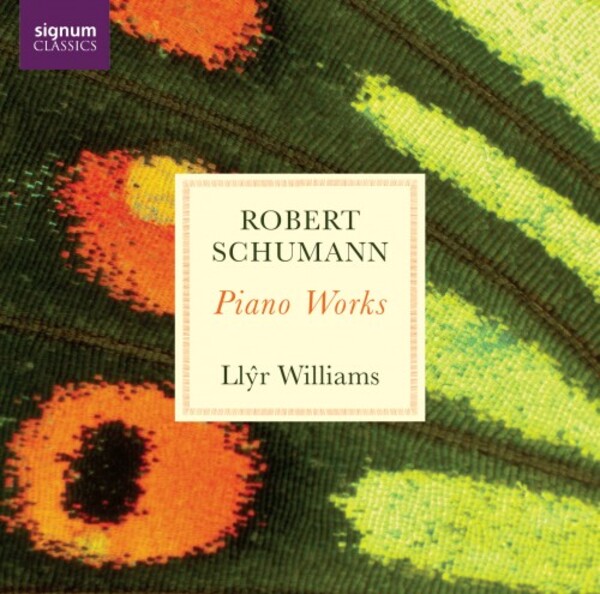SCHUMANN Piano Works (Llŷr Williams)
View record and artist detailsRecord and Artist Details
Genre:
Instrumental
Label: Signum Classics
Magazine Review Date: 02/2024
Media Format: CD or Download
Media Runtime: 153
Mastering:
DDD
Catalogue Number: SIGCD756

Tracks:
| Composition | Artist Credit |
|---|---|
| Fantasie |
Robert Schumann, Composer
Llŷr Williams, Piano |
| Papillons |
Robert Schumann, Composer
Llŷr Williams, Piano |
| Humoreske |
Robert Schumann, Composer
Llŷr Williams, Piano |
| Davidsbündlertänze |
Robert Schumann, Composer
Llŷr Williams, Piano |
| (4) Nachtstücke |
Robert Schumann, Composer
Llŷr Williams, Piano |
| Faschingsschwank aus Wien |
Robert Schumann, Composer
Llŷr Williams, Piano |
Author: Stephen Cera
This pair of generously filled discs attests to the Welsh pianist Llŷr Williams’s passion for this repertoire and his capacity to embrace its soaring imagination, eccentricity and fantasy.
Williams is impressive in Davidsbündlertänze, Schumann’s path-breaking collection of musical fragments, in which the composer contrasts the imaginary characters of the dreamy introvert ‘Eusebius’ and the ardently capricious ‘Florestan’. Listen to the ease with which he clarifies rhythmic displacements in Nos 4 and 6, the appropriately electric jolt he applies in No 8 and the boisterous humour he conveys in No 12.
The recorded sound is on the bright side, so when the pianist bangs the opening bass octave of No 15 it comes as a bit of a shock. My preference is for a darker, more plangent tone in this music. Yet while the coda of No 13 could have a heightened misterioso quality, in No 17 the pianist effectively conjures Schumann’s twilit world, akin to the inward passages of Kreisleriana and the C major Fantasie.
The Humoreske, a single extended movement full of heartfelt feeling as well as irony, receives perhaps the most successful performance overall. Williams captures the alternating extremes of mood, shaping the work in a manner that defies its episodic nature, scrupulously dispatching the scurrying scales, displaced accents and obsessive off-centre rhythms. The treacherous and slippery octaves in the central Intermezzo pose no terrors.
In the Innig section (track 19) the pianist tastefully captures the quicksilver changes of mood. In the same vein, Sehr lebhaft (track 20) takes wing in appropriately breathless, headlong fashion. The ensuing Mit einigem pomp is superbly characterised, with just the right touch of pomposity.
The admirable performance of the C major Fantasie doesn’t reach quite the same level. Williams voices its interweaving lines with fervour and clarity, and articulates the rhythms precisely, yet when the finale arrives, the range of colour recedes (eg scant differentiation between pianissimo and mezzo-forte in the passage beginning at 6'49"). This is a work that the composer described in a letter to his wife as ‘the most passionate thing I have ever written’.
Fine as these renditions are, they appear in a crowded field. For Davidsbündlertänze, among other excellent versions, I remain partial to a superb 1971 recording by the late William Masselos (available as part of a seven-CD Sony compilation of his complete recordings for RCA and Columbia). Still, anyone looking for an ample selection of Schumann’s piano music need not hesitate. The fine booklet notes by Geraint Lewis are reproduced in tiny type that had me grasping for a magnifying glass.
Discover the world's largest classical music catalogue with Presto Music.

Gramophone Digital Club
- Digital Edition
- Digital Archive
- Reviews Database
- Full website access
From £8.75 / month
Subscribe
Gramophone Full Club
- Print Edition
- Digital Edition
- Digital Archive
- Reviews Database
- Full website access
From £11.00 / month
Subscribe
If you are a library, university or other organisation that would be interested in an institutional subscription to Gramophone please click here for further information.




